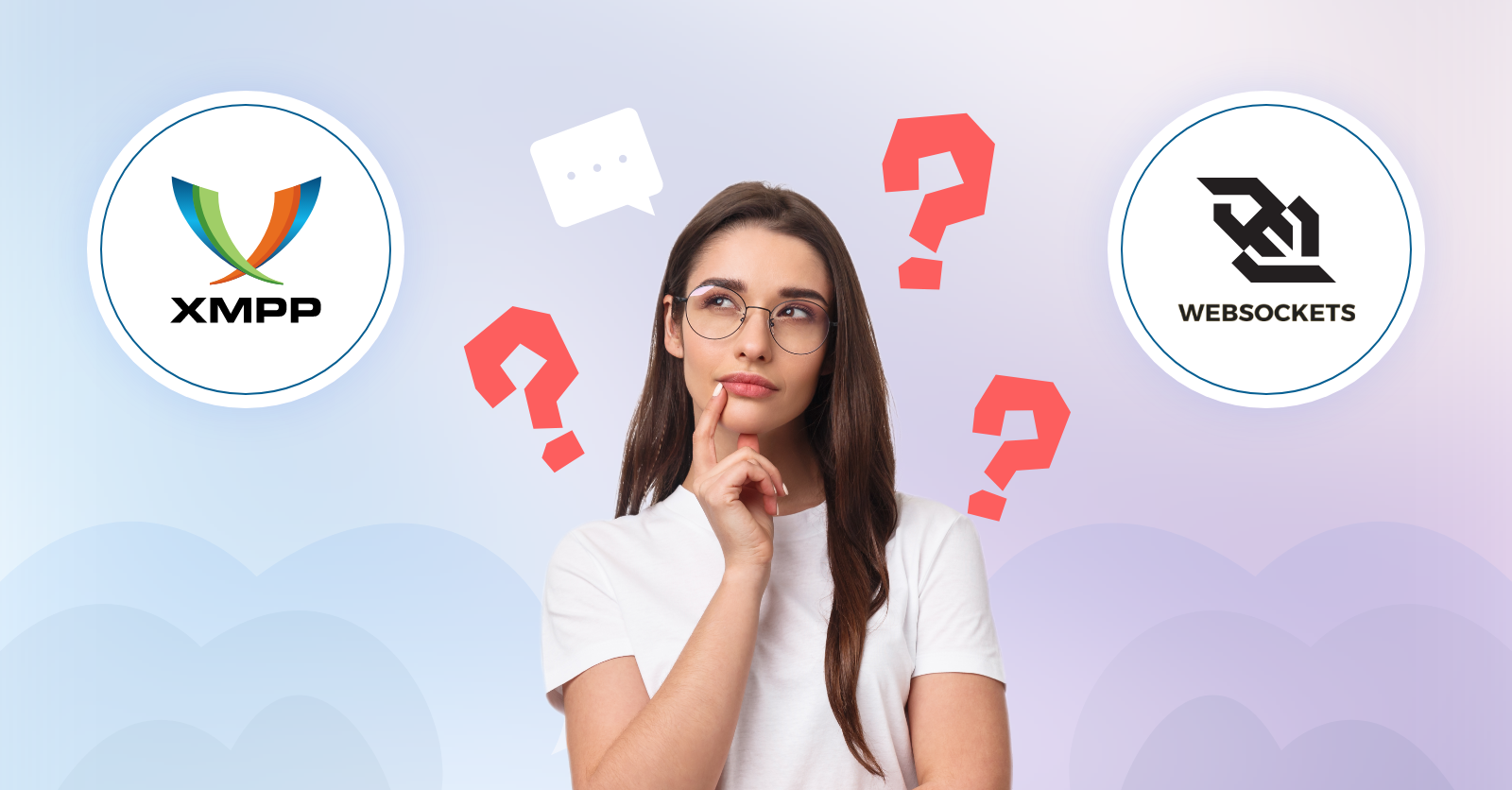"Get to know about XMPP vs WebSocket protocols, their specs, features, architecture, platform support, and security for building a highly interactive and responsive chat app in this 1000-word long article."
Back in the 2000s when chat apps emerged, XMPP was one of the driving powerhouses in transmitting messages in real-time. But as decades passed, XMPP stands as a widely used protocol along with Websocket.
Why is it universally accepted? How is it that the protocol survived through time? What makes it the best? or when should one use XMPP chat apps?
We will find out the answers to all the above questions in the blog below.
What is the XMPP Protocol?
XMPP (eXtensible Messaging and Presence Protocol) is an open-source communication protocol or a chat protocol that supports the transmission of small chunks of XML data between two network endpoints in real-time. It gained a lot of popularity among developers due to the presence of a rich plugin community.
With the help of this plugin, we can easily employ extensions to support asynchronous messaging, signaling for VoIP, video, and IoT apps, and social networking services.
So besides sending and receiving messages, XMPP components can also manage contact lists, broadcast user's statuses, block users, and look after other core functions of a chat app.
A few other aspects of XMPP are that it describes the behavior of communication by defining TCP as the transmission protocol to send XML fragments, supports textual data in XML format, its syntax is verbose, and to overcome firewall blockage issues, XMPP community developed HTTP transport.
Now that we got hold of its definition, let us travel around its work clature and security parameters.
 View Website
View Website
 View Website
View Website
 View Website
View Website
XMPP Architecture
XMPP makes use of client-server architecture and every client in a network is assigned an XMPP address or JabberID to identify the others. This address is nothing but an IP address with an optional node and a server's username.
Once the above step is done, messages are routed between clients and servers only. And since the protocol makes use of decentralized server technology, developers can create their servers for routing to happen.
Plus, the architecture also makes use of XMPP gateways to handle communication between XMPP protocol and other protocols like SMS and SMTP. In simple terms, it means allowing users to communicate via different message types like SMS, emails, and XMPP.
If you find the text to be overly hazy, below is a pictorial representation of how XMPP works:
<@image>
XMPP Security
It comprises two security levels:
- SASL (Simple Authentication and Security Layer) for secured authentication.
- TLS and OMEMO for secured transmission of text.
Because of the presence of multiple security standards, XMPP stands as the wisest choice to build chat applications.
XMPP Platform Support
As XMPP holds an entire list of XMPP libraries and tools, the protocol can be used with any programming language like .NET, C++, Rust, Swift, Java, and more.
XMPP Highlights
- Possess rich community plugin
- Follows a decentralized client-server architecture
- XMPP gateways
- Multiple layers of security
- XML data format
XMPP Merits & Demerits
Below is a detailed analysis of the pros and cons of the XMPP real-time chat protocol
Pros:
- XMPP has plenty of extensions thereby reducing development time.
- Comes flexible with other messaging formats because of gateways.
- Highly secure with strong community support.
- XMPP was initially developed keeping instant messaging apps in mind so it holds multiple features.
Cons:
- As XMPP uses XML which is a verbose data format, it is less memory efficient than JSON.
- Some developers can add firewalls to block messages.
- Message transmission and delivery is slower than WebSockets.
- Developers need to separately add QoS and data integrity on the top of XMPP.
There you go with all the must-knows about the XMPP protocol. Now let us look at,
What is the WebSocket Protocol?
The WebSocket protocol or RFC 6455, published by IETF in the year 2011 is a more recent and thin layered protocol built atop the TCP/IP stack. This means, WebSocket offers full-duplex and low-latent communications between browsers and servers.
And since the protocol supports the transmission of binary data or text, its transmission rate is faster when compared to XMPP. Further, like XMPP, it also has a rich community with several plugins and libraries and has an HTTP fallback feature to meet up with corporate firewall blocking.
Plus, its unique aspect is the tendency to add subprotocols under it like SOAP, WAMP, MQTT, and even XMPP. Now, let us look at its architecture.
WebSocket Architecture
WebSocket makes use of a centralized client-server architecture that allows transmission of messages between clients via servers.
Clients must first connect with the server through an HTTP handshake and once it is established, the WebSocket protocol offers a full-duplex connection between client and server until the session pertains.
Below is a clear-cut pictorial representation of WebSocket architecture: <@image>
WebSocket Security
When compared with XMPP, its security is not as mature as XMPP, meaning developers cannot find authentication and identity features for free and must code those on their own. Hence, TLS is used for security purposes.
WebSocket Platform Support
WebSockets supports major languages like JS, .NET, Java, Python, and more. Similarly, in client platforms like Windows, macOS, Linux, or Android, all browsers support WebSockets API to connect to WebSockets servers.
WebSocket Highlights
- It is ideal to build real-time use cases.
- Comes with a centralized client-server architecture.
- Transmission happens in binary or text formats.
- Supports SOAP, WAMP, XMPP, and MQTT protocols.
- Built atop TCP/IP stack thus improving connection and reducing latency.
WebSockets Merits & Demerits
Below is a detailed analysis of the pros and cons of the WebSocket real-time chat protocol
Pros:
- WebSockets can handle multiple concurrent connections between clients and servers.
- It supports transmission of binary data and UTF-8 plain text, images, and videos.
- Messages to and fro in a session are handled by a single WebSocket connection.
- Supports data integrity and ordering.
Cons:
- WebSockets are less secure than XMPP chat protocol.
- They are less mature and have a centralized architecture.
- It has limited extensions though multiple libraries.
- In case of sudden termination of WebSocket connection, extra codes must be written to poll server and re-establish connection.
So far we saw how the two protocols differ from each other with respect to security, performance, and architecture. And now, we will see the head-on-head comparison between XMPP and WebSockets for a quick understanding.
XMPP vs WebSockets: Differences between them
The table below gives a clear understanding on the clash between WebSockets vs XMPP, which may help developers to choose the right protocol for building chat service. XMPP Decentralized server-client architecture Primarily for building chat appsbuilding chat apps Can establish limited number of connections Can transmit only text data Transmission speed is slow Multiple layers of security
WebSockets Centralized server-client architecture Works for any use cases Supports multiple connections Both binary and text data Faster than XMPP Only TLS security
That’s the basic differences between the two chat protocol giants. Now let us head to finding out which of the two is best for building chat applications from scratch?
XMPP vs WebSockets: Which is best for chat app development?
Choose the best option!
When we weigh the two options that we have in hand: XMPP or WebSockets, both stand as strong contenders for building chat apps or instant messaging solutions. Hence, the choice of technology depends on factors that we will discuss below.
Choose XMPP as,
- Mature technology than WebSockets
- Offers multilayered security by default
- Flexible and has rich extensions which makes it easy to extend its usage on different frameworks
- Have strong community support
Whereas choose WebSockets as it,
- Offers good platform and browser support
- Has extensions with plenty of libraries to add chat features
- Very fast and performs well in transmitting data quickly
- Supports multiple client connections per server
Did you get an idea of which protocol to choose for your chat app development for Android, iOS, or the Web? But let me tell you friends that there are other instant messaging protocols as well.
What are the other instant messaging protocols?
Besides XMPP and WebSockets, there are other chat app protocols or instant messaging protocols like:
-
MQTT: Message Queuing Telemetry Transport is a lightweight messaging protocol that is solely designed for machine-to-machine communication. It works well even during unstable network conditions and poor CPU capacities as well.
-
RCS: Also known as Rich Communication Services is a protocol that's used for developing group chats and multimedia support. It is mainly used to build Android messaging apps.
-
IRC: The Internet Relay Chat protocol uses a client-server model to implement instant messaging solutions on computers. Some of the features that it can help build include private messaging, file sharing, and chat rooms.
-
WebTransport: This is nothing but Web API that's developed as an update to WebSocket. As of now, it is not widely used but may see its usage in the future.
Wrapping Up!
Chat applications are here to thrive in the future and its usage ain't going to stop anytime soon. So, it is up to developers to pick the best protocol for chat applications based on the business needs. 

Comments (0)